January 27, 2020
Admin
12 min.
History & Ancient Literature
The Egyptian Book of Dead Egyptian Book of the Dead Spell 125Egyptian Book of the Dead Bible
Disclosure : When you purchase a service or a product through our links, we sometimes earn a commission, at no extra cost to you.
11 Lesser Known Facts About The Egyptian Book Of The Dead, That Would Surprise You
“Death is not the opposite of life but an innate part of it” – Haruki Murakami
Thousands of years ago, people of ancient Egypt also believed that death was not the end of life, but the beginning of life in another realm, which would be permanent or everlasting. Thanks to numerous movies on the subject, people in the modern world have a very vivid idea about the Pharaohs and their obsession with the afterlife.
The above facts can be seen clearly from the number of people coming from distant places to see the Pyramids every year. However, there is a small problem with these popular ideas - most of them are not true, including the ones related to the Egyptian Book of Dead.
Mummification, perhaps the best procedure of Ancient Egypt to be known to modern people, was just the beginning of a long and dangerous journey, starting after death to a world of eternal bliss, for ancient Egyptians. The journey to reach this dream destination was not easy and could be only undertaken successfully if you had a guidebook with magic spells & other instructions to overcome this perilous journey – The Egyptian Book of the Dead.
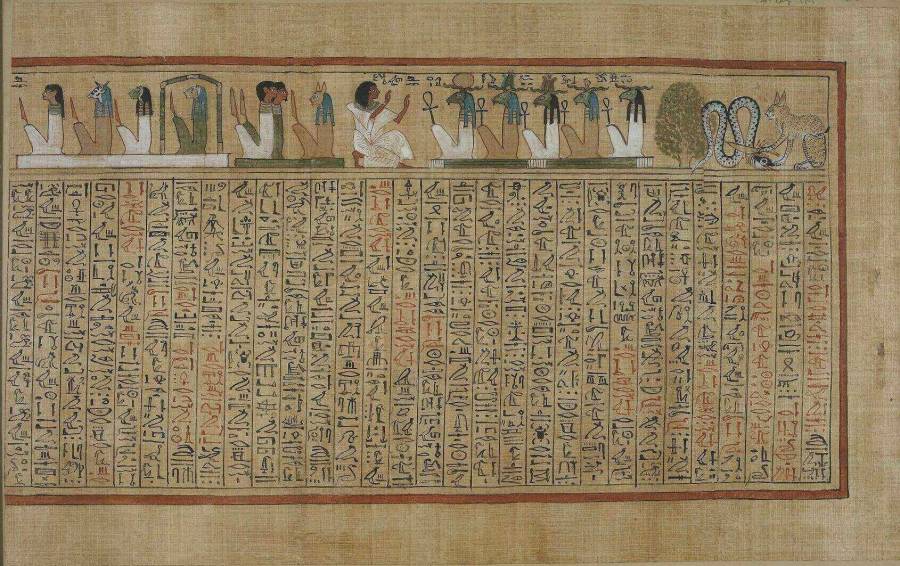
Book of the Dead of Hunefer, sheet 8.
To understand the Egyptian Book of the Dead better, we have to travel thousands of years back in time to Ancient Egypt, when magical spells formed an integral part of an instructional manual describing the journey through the afterlife in the Egyptian Book of the Dead. Some of the finer points of this ancient text are -
1) The Egyptian Book of Dead is Neither A Book Nor that is Its Original Name
-
Egyptian Book of the Dead is not a book in the classical sense of the word. The Egyptian Book of the Dead contains a loose collection of funerary spells that was written in hieroglyphic or hieratic script on papyrus scroll (often with illustrations) to serve as road maps and help the souls of the dead ancient Egyptians to navigate properly in the afterlife.

Book of the Dead - Papyrus of Gautsoshen.
-
The name of the text was not certainly – The Egyptian Book of Dead in ancient Egypt, it is rather a new term coined by modern western scholars (German Egyptologist Karl Richard Lepsius, to be more precise) in the 19th century. The ancient Egyptian name was more like “The Book of Coming Forth by Day” or “Spells of Going Forth by Day”.
2) The Egyptian Book of Dead Didn’t Start Off as A Book
-
A lot of people want to know how old is the Egyptian Book of the Dead? For those curious readers, the following lines will provide the answer.
-
One of the first examples of the now well known – Egyptian Book of the Dead, was found in the sarcophagus of a 13th dynasty queen – Mentuhotep, who lived somewhere between 1633 to 1552 BC. However, the most important thing to know here is that the Egyptian Book of the Dead did not first originate as a book (or a papyrus scroll).
-
Most of the scholars agree that the Egyptian Book of Dead did not first originate in the form of a papyrus scroll. The pictures and texts written in the Egyptian Book of Dead were inspired (before they were written in papyrus) from earlier inscriptions in Pyramids, which are known as Pyramid Texts.
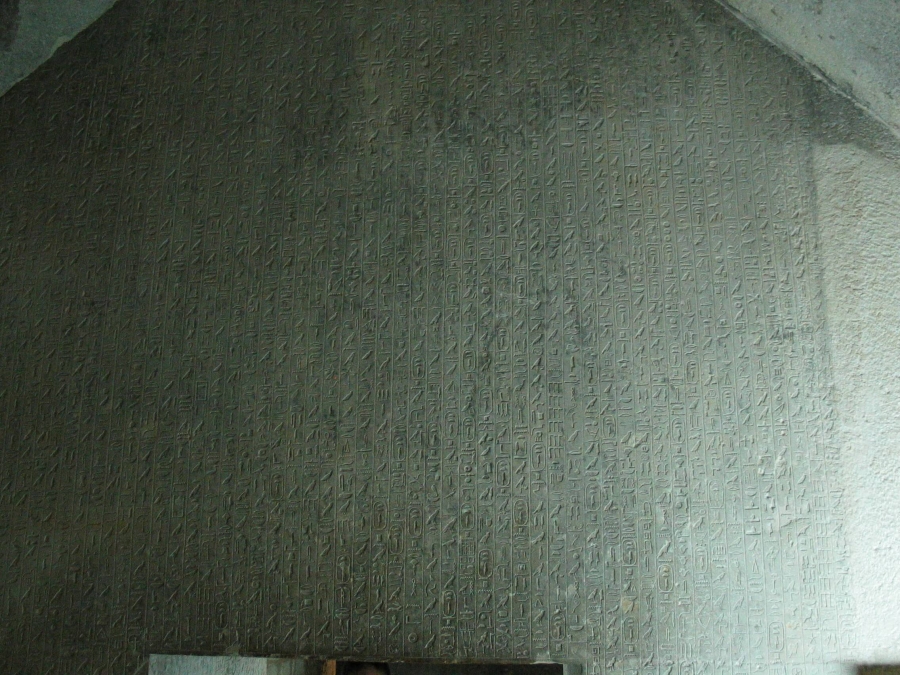
Pyramid Texts from Pyramid of Teti I in Saqqara.
-
These Pyramids Texts, which go back to the period of the Egyptian Old Kingdom, were carved into subterranean walls and sarcophagus of the pyramids. Some of these Pyramid Texts have been found to go back to a period of around 2400 BC. At that period the text was written and meant only for the Pharaoh, so he could take his place among gods after his death.
-
As time passed the funerary texts also got modified into a new form, known as Coffin Texts during the First Intermediate Period (2181 BC to 2040BC). These texts were named so, as they were mostly found on the inner surface of the coffins. These texts had a new language, & began to show illustrations for the first time. The availability of Coffin texts extended to even the elite than just the pharaoh as was present previously.
-
By the time of Queen Mentuhotep of the 13th dynasty, the Egyptian Book of the Dead contained many newer spells along with those derived from ancient Pyramid Texts and Coffin Texts.
-
During New kingdom as the popularity of the Egyptian Book of Dead began to peak, the typical practice of writing it on a papyrus scroll became well established (supposedly starting around 1475 BC).
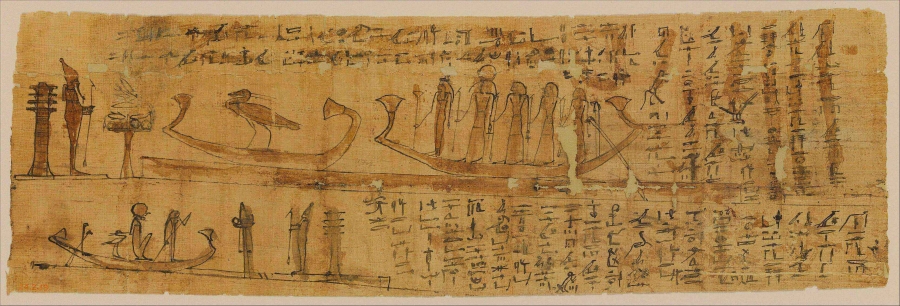
Book of the Dead - Papyrus with Chapters 100 and 129.
-
The soul of the dead one after the funeral could wake up into an unaware state in the absence of the Egyptian Book of the Dead. However, with the book around, the deceased would know who they were (spell 25 would ensure this) and what they should do now to properly proceed further in the afterlife.
3) No Uniform Version of The Egyptian Book of Dead Was Present
-
One of the most lesser-known facts regarding the Egyptian Book of the Dead is that there is no uniform version present, no two books were expected to be exactly the same. Many different versions of the Egyptian book of the dead have been found containing a different selection of magical and religious texts & the illustrations present in them also vary from one another.
-
One cause of this was during the period of Egyptian History between Middle & New Kingdoms, the book was no longer a luxury reserved for royalty only. Even the members of the upper echelons of ancient Egyptian society were opting for their own personal Egyptian Book of the Dead, to have a smooth passage in their afterlife. In these cases, the people chose their own spells, which they believed would help them best in their progression to their afterlife.
-
By the time of New Kingdom (1539 -1075 B.C.), the popularity of this text had so much increased that mass-produced version of the Egyptian Book of Dead, began to appear. In these blank spaces were left, in which the owner’s name could be put later, thus personalizing the Egyptian Book of the Dead.
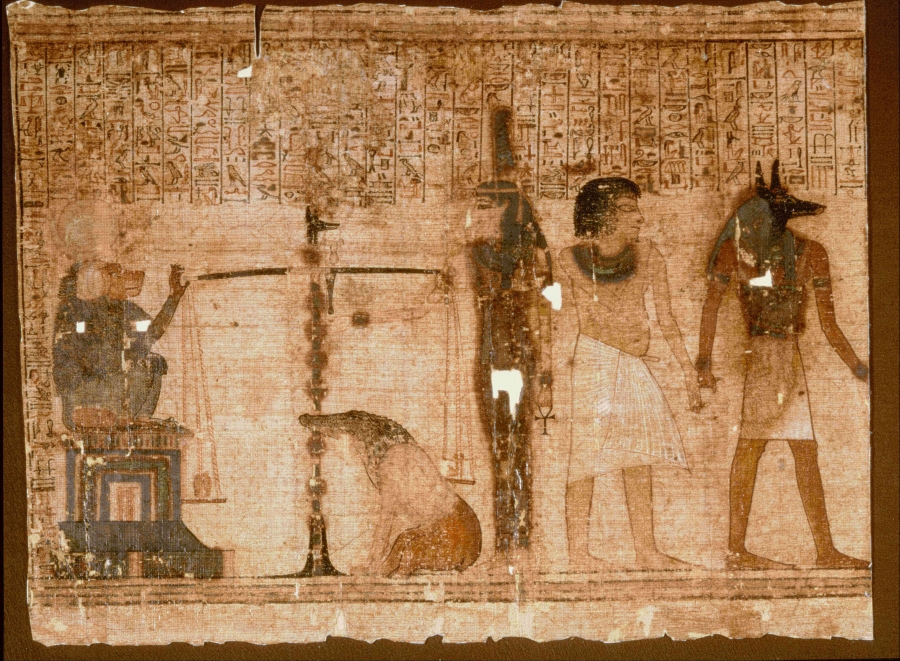
Egyptian Book of the dead of Kenna found in Egypt. New Kingdom, 18th dynasty, 1325 BC.
-
Custom made version was also written for the elite who were ready to pay sufficient money. For these services, special scribes were enlisted. The scribe would ask the would-be owner of the Egyptian Book of dead the kind of life they had led which would determine the kind of journey, these men would face in the afterlife. Then depending on probable challenges expected in the afterlife, the scribes would write down a correct spell that the particular individual would need.
-
The owners of the Egyptian Book of Dead could get the scribes to add more spells in the book if they could afford it. The choice extended to the number of chapters desired, the quality of papyrus used for the purpose & even also the type of pictures desired. Thus, with the right amount of money, the Egyptian Book of the Dead could be improved both quantitatively and qualitatively.
-
By the year 650 BC, the spells of The Egyptian Book of Dead was beginning to take a more standardized uniform structure in the sense that the number of chapters (or spells) got fixed at 190 spells, however, people still had the liberty to add or remove things to the text, as per their personal wishes.
4) Ancient Egyptian Book of the Dead, Journey Through the Afterlife
-
Once the Egyptian Book of the Dead was with a person his afterlife was expected to be secured, but by no means, this journey would be easy.
-
At the time of funeral ceremony parts of the Egyptian Book of the dead would be recited by the priest in the tomb followed by some rituals which would prepare the dead for their journey to the afterlife.
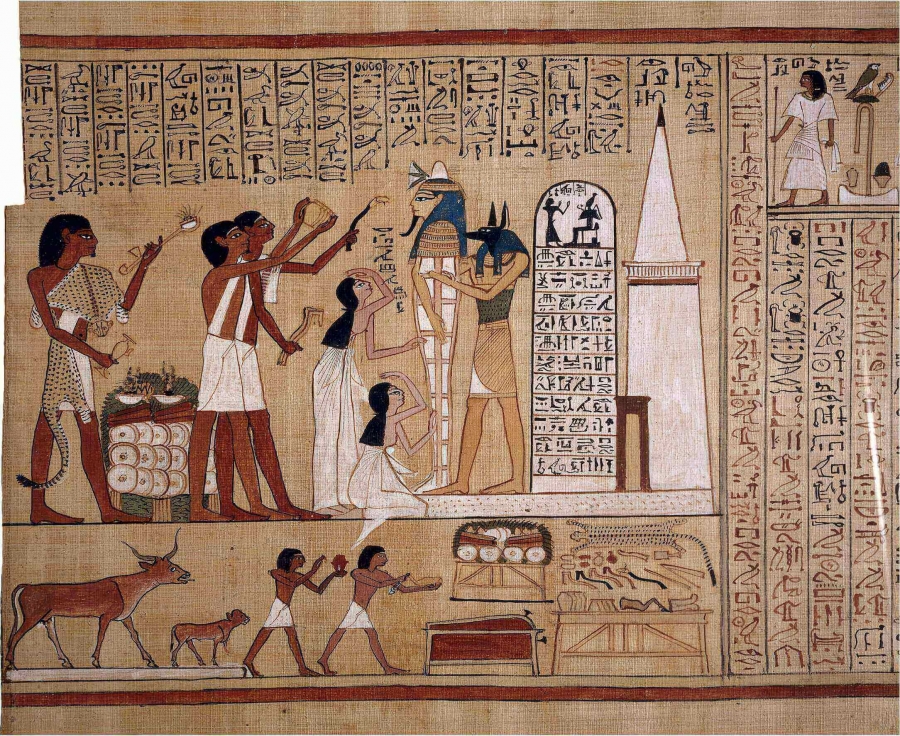
Opening of the mouth ceremony.
-
The dead would have to later undertake a journey under the earth’s surface, which would be done on the boat of the Sun god. Here it would be important to mention that the ancient Egyptians believed that when the Sun, set in the west, he disappeared under the earth traveling to his starting point to the east.
-
The dead traveling on the Sun god’s boat would encounter many dangerous creatures, during this journey. Most dangerous among these would be the evil serpent – Apep, whose intention was to stop the boat of the Sun god and bring disaster to the world. The dead traveling in the ship could escape from this monstrous creature by reading chapter 7 from the Egyptian Book of the Dead to it.
-
After successfully bypassing Apep, the deceased would have to pass through a labyrinth with multiple gates. Here again, the Egyptian Book of the Dead would come in handy, when the dead could call the gate by its proper name and offer a correct prayer from the text. With the correct answer, they could proceed to the next destination, which was called the Hall of Truth.
-
In the Hall of Truth, the deceased would be judged for his actions during his life, by 42 judges who would be headed by Anubis – The god of the Underworld. Here the deceased would have to declare that they have not committed any of the 42 grievous sins that would deny them the right to stay in paradise with the heavenly company of the gods, till perpetuity. These Negative Confessions in the Egyptian Book of the Dead were also known as The Declaration of Innocence in the Egyptian Book of the Dead and were addressed to a specific judge (42 sins = 42 judges).
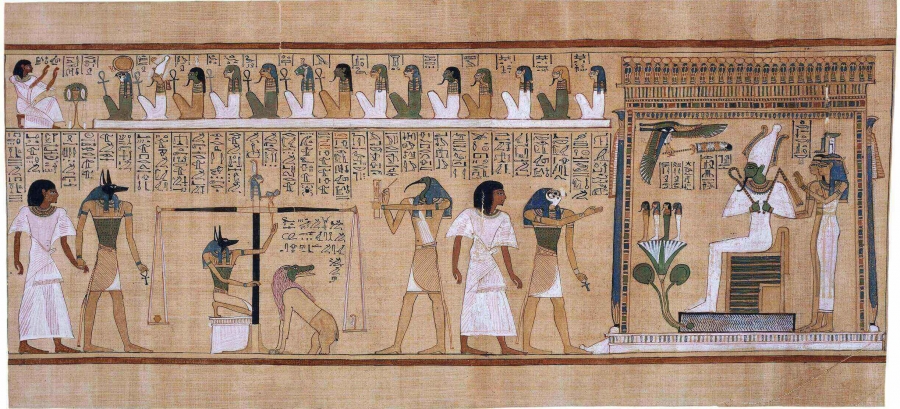
The judgement of the dead in the presence of Osiris.
-
Egyptian Book of the Dead Spell 125 is considered of significant importance as here the list of the negative confessions were described in detail. The list of confessions describes general good behavior & moral conduct. Some of these were – Not stealing, not hurting, killing or terrorizing others and not having committed adultery.
-
Once the confessions were over, Osiris, Anubis, Thoth, and the 42 judges would discuss among themselves, if the confessions were valid or not. If the confessions were considered valid then the deceased would go on to face the next test.
-
After the negative confessions or the declaration of innocence came the final test – Weighing of the Heart. In ancient Egypt, the heart was believed to carry a person’s character and personality to the afterlife. Hence even during the mummification process, the heart was left behind in the body, so that it could be surrendered in the afterlife to the gods for judgment.
-
The weighing of the heart in Egyptian Book of the Dead was done with the heart (signifying the action of the individual, during their lifetime) being placed on one side of the scale and an ostrich feather, which symbolized the truth & justice (and represented goddess Maat) being placed on the other.
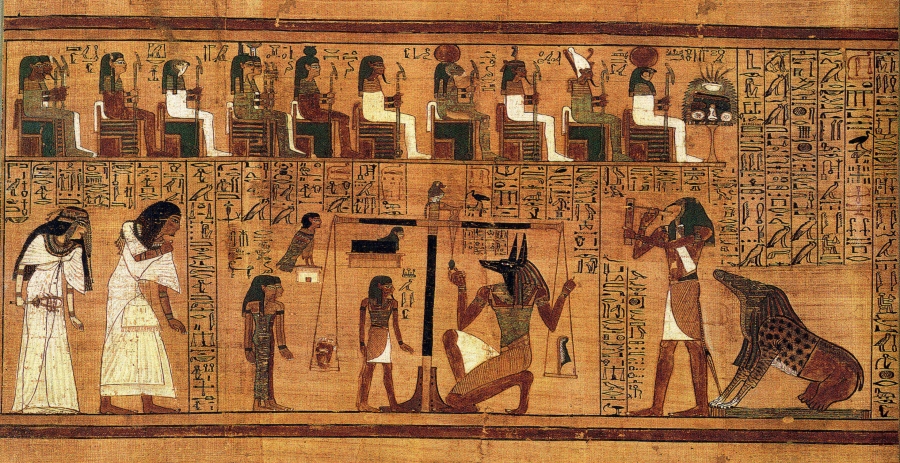
Book of the Dead written on papyrus showing the Weighing of the Heart in the Duat using the feather of Maat as the measure in balance.
-
If the heart was found to be lighter than the feather then the deceased would go to paradise. However if the heart was heavier then the feather, the deceased would be subjected to horrible punishment. The heart would be thrown to the ground, where it would be devoured by a monster goddess – Ammit, and the soul would disappear forever.
5) Afterlife Was Not Always Guaranteed
-
In ancient Egypt, the afterlife was not guaranteed to everyone. Even after procuring the Egyptian book of Dead, the deceased had to face many challenges in the afterlife, which were expected to be overcome by reciting the spells written in the Egyptian Book of the Dead. However, there was no guarantee that the soul of the deceased would survive all the trials & tribulations, that it would encounter in the perilous journey of the afterlife.
-
The challenges included dangerous mythical creatures, passwords to open certain gates & many other difficulties which included - knowing the names of different gods & their responsibilities, being judged by the 42 judges and finally weighing of the heart.
-
In case, the heart was heavier than the feather, then it would be thrown to the floor, where it would be eaten by a monster goddess – Ammit/ Ammut. In this case, the afterlife of the deceased would come to an early & unpleasant end as the soul would cease to exist.
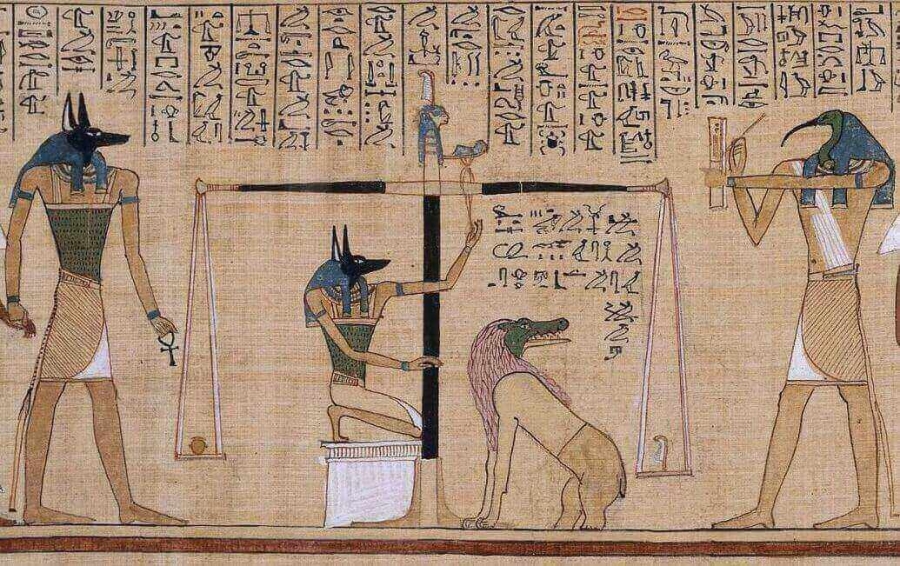
Weighing of the heart.
-
Egyptian Book of the Dead also describes punishments that could be given to those deceased who were judged to have sinned. Some of these were being subjected to eternal hunger and thirst, being forced to eat one’s own fecal matter & drink urine, being boiled in hot water, or being eaten by a beast.
6) Problems of the Heart in Afterlife
-
The Egyptians very well knew that not all people who were declaring themselves to be innocent in the afterlife, may not be so in their real life. So, it was very important to ensure that one’s heart should not give them away when they were being judged by the gods.
-
To get away from this problem, a scarab (large beetle, considered sacred in ancient Egypt) shaped lucky charm, known as Heart Scarab/Scarab of the Heart, was placed over the heart of the dead (before mummification) with the chapter 30 of Egyptian Book of the Dead, inscribed on the back of it.
-
The chapter 30 of the Egyptian Book of the Dead, was to ensure that Heart of the deceased wouldn’t give away their weakness (and contradicting the deceased, by presenting inconvenient truths) at the time of weighing of the heart. The intention was that the deceased could enter paradise in the afterlife, even if their life was not as pure as they declared it out to be.
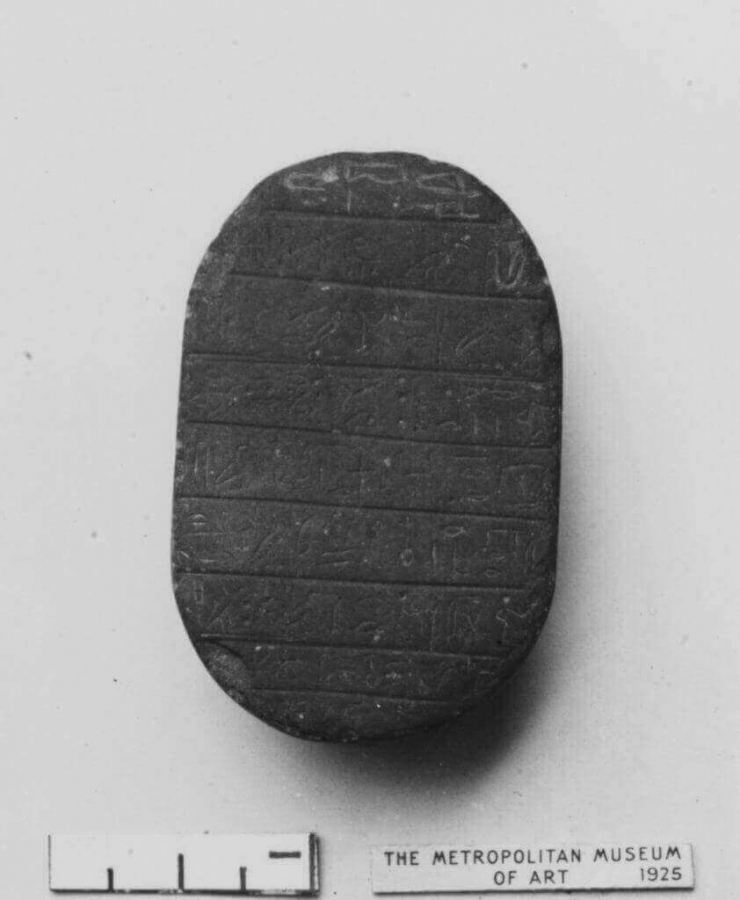
Heart scarab inscribed for Gautsoshen. ca 1070 -945 BC.
-
According to some sources, the Heart Scarab also acted as a replacement in case anything happened to the real heart.
7) Field of Reeds – The Heavenly Paradise
-
Reaching paradise, which in this case was known as Field of Reeds or Fields of Aaru was not easy. However, following the advice that was given in the Egyptian Book of Dead strictly, was expected to make this possible.
-
Those who managed to pass the weighing of the heart would later go to the shore of Lake of Flowers, where the divine ferryman would take them across to the Field of Reeds, the ancient Egyptian version of paradise.
-
The Field of Reeds would consist of many fertile fields, surrounded by mountains and rivers running through them.
-
In the Field of Reeds, the deceased would be finally once again among their loved ones & pets, who had died before the deceased (in our discussion). The deceased person would also find exactly the same kind of home in this Fields of Aaru, like the one, in which they had lived in during their lifetime.
-
In this Field of Reeds, the deceased soul would be finally at an eternity of bliss and everlasting peace, with all their near& dear ones, pets and all those things that they liked during their lifetime being close to them.
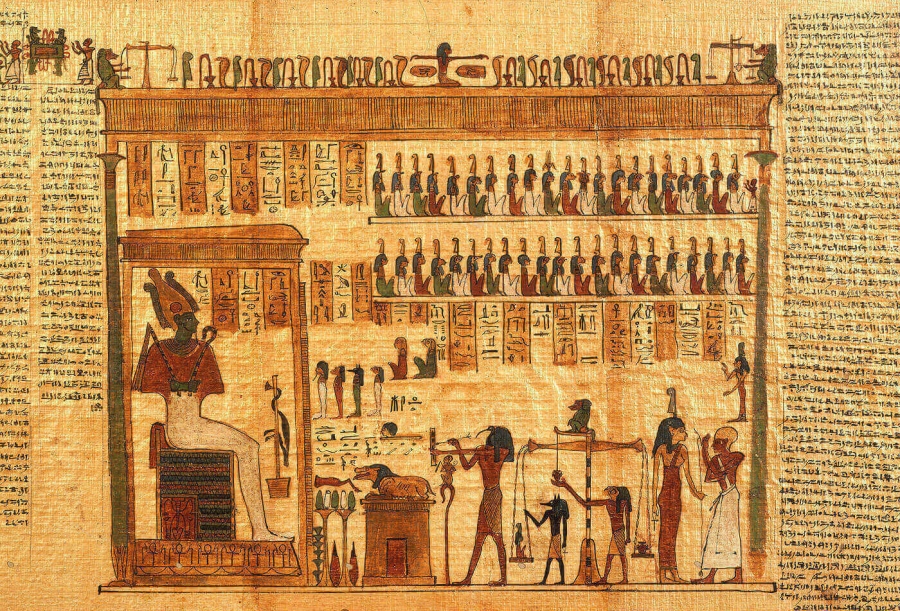
Book of the Dead, Egypt.
-
The deceased living in the Field of Reed was also expected to take an active part in planting and reaping crops. However, if the soul of the deceased was not interested in working in the afterlife, they could take the assistance of their own personal army of servants.
-
These servants to help the deceased were the Ushabti - statues which were placed in the tombs among grave goods, who in the afterlife of the deceased, would work as a servant to do the manual work entrusted to their masters by the gods. Spell 6 of the Egyptian Book of Dead, gives instruction to the soul of the deceased as to how to bring these ushabtis to life, to do their work in the Field of Reeds.
-
With the Ushabti doing all the work, the deceased could finally enjoy their life in paradise.
8) Pen Was Mightier Than Sword
-
The writers of the Egyptian Book of the Dead was quite proud of their work and often declared that they along with their children would prosper forever for making so valuable contribution to society.
-
The scribe would go on to boast that when his time would come to depart for the afterlife, he would easily get entry into the paradise, because of his endeavors of writing down the spells in his lifetime. He believed that he would get to live with the greatest Kings that Egypt had ever produced & would stay even in the company of Osiris himself.
-
It was obvious that the writers of the Egyptian Book of the Dead believed that their position in the afterlife, was much more secure than even the Kings who ruled the land, as they had to clear many obstacles to reach the desired paradise.
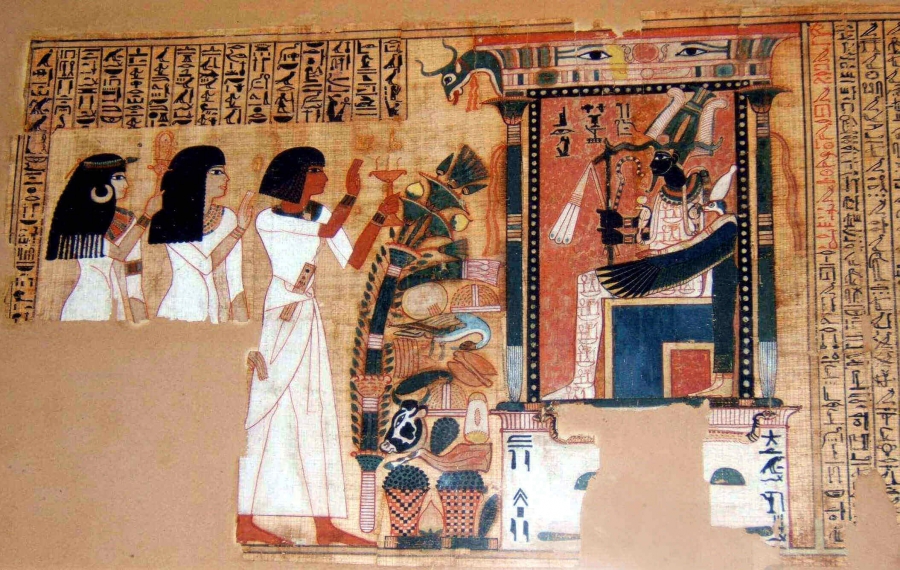
Part of the Book of the Dead of the scribe Nebqed, under the reign of Amenophis III (1391-1353 BC), 18th dynasty.
9) The Magic of The Egyptian Book of Dead Was Not Meant for Living People on Earth
-
Egyptian mythology has seen a resurgence in modern years, thanks to its real and fictional depictions in various television programs and movie productions. Unfortunately, not all depictions are historically accurate, especially the ones related to the Egyptian Book of the Dead.
-
Many fictions based tv shows and movies show that the Egyptian Book of the Dead was used by ancient Egyptians for performing magic in different religious and mystical ceremonies, which is then attempted by people of the modern world, who have somehow discovered the book. However, this is not a real fact.
-
In ancient Egypt, the Egyptian Book of Dead had no magical functional use for those who were living. It was meant as an instruction manual or a guidebook only for the deceased who were venturing into the unknown afterlife for the first time. The magic spells mentioned in the Egyptian Book of the Dead worked only in the afterlife.
10) Egyptian Book of the Dead, Bible Comparison
-
Egyptian Book of the Dead vs Bible comparison is again one of the most misunderstood issues that are associated with this ancient text.
-
When the Egyptian Book of the Dead was first found in the tombs, it was mistaken as a religious text and hence was believed to be equivalent to the Bible of the Christians. However, this example was not based on logical findings.
-
As discussed previously and described above, the Egyptian Book of Dead was a funerary text for the afterlife (with no 2 copies being exactly the same) and not a traditional religious book.
11) The Book of Dead Was Not Only Egyptian
-
We have been discussing for a very long time about the Egyptian Book of Dead. However, before concluding our discussion, it is important to mention that although most popular, the Egyptian Book of Dead was not the only book of that name.
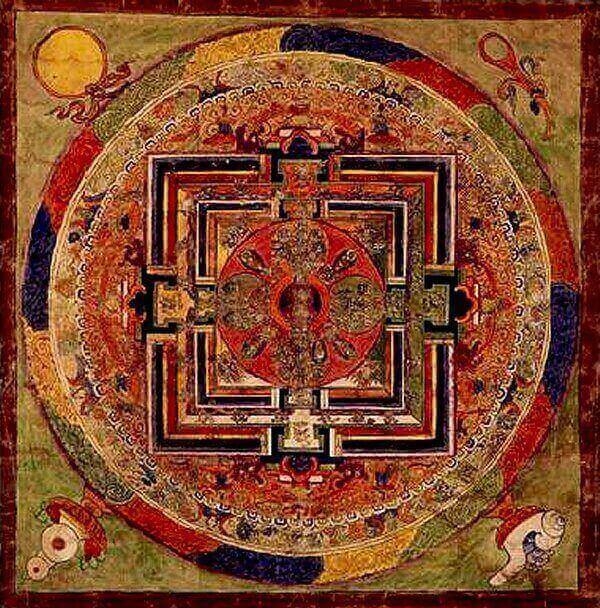
Centuries old Zhi-Khro mandala, a part of the Bardo Thodol's collection, a text known in the west as The Tibetan Book of the Dead.
-
There is another book of dead known as – “The Tibetan Book of Dead”, which is a collection of texts that also deals with death and the afterlife, that was written in the 8th century AD by Padma Sambhava, an ancient Buddhist teacher.
-
Actually, named Bardo Thodol (liberation by hearing on the after death plane) in Tibetan, it is one of the best-known works of Nyingma (oldest of the 4 major schools of Tibetan Buddhism) literature.
-
There is a huge difference between the fundamental aims of books from these 2 different cultures.
-
The Tibetan Book of the Dead is read out by a living person to a dying person or a person who has recently died with the intention of easing their consciousness through death and assist them to escape the life, death and rebirth cycle.
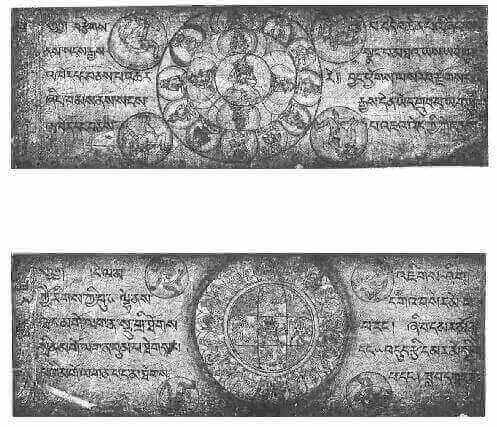
Manuscript of the Bardo Thodol.
The Egyptian Book of Dead Summary
The scribes who wrote the Egyptian Book of Dead created an ancient text which was very similar to real life. After death, the soul of the deceased could reach paradise and lead a life of everlasting bliss only after facing and triumphing over multiple challenges. Like real life in the afterlife too, a person could reach his destination if he could manipulate the situation in his favor. Antagonizing god was a strict no-no and it was very important to give the impression of being a good human being to them.
The Egyptian Book of Dead did undergo some changes (both in contents, dimensions & other details) with the passage of time as the culture gradually changed. However, the ambition & desire of ancient Egyptians (like all people of the modern world) for a dream to live happily ever after did not change with time. Perhaps it is the quest for eternal happiness, that remains the same, irrespective of the place and period where a person may stay in the world.
(DECLARATION - All the images used in this site, are either from personal collection, or are images available in Public Domain. The owner of this website is grateful to all those, who donated their images to – Wikipedia, Wikimedia, Flickr, Pixabay, Picryl and all other sites; for free use, as images in Public Domain.)
Disclosure: When you purchase a service or a product through our links, we sometimes earn a commission, at no extra cost to you.













